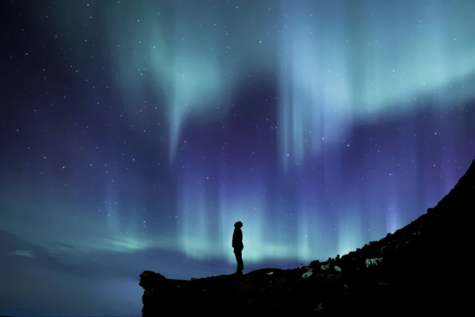Dancing lights: The science behind Auroras
April 11, 2018
People travel thousands of miles to see mesmerizing auroras, but most people don’t know what they really are.
According to How Stuff Works, an aurora is created when highly charged electrons from the sun interact with elements in the earth’s atmosphere. These electrons come from solar winds, which are particles stripped from the corona, the sun’s outermost layer. Particles in the corona reach up to 1.1 million degrees Celsius (about 2 million degrees Fahrenheit). At this temperature, particles move so fast and are so far away from the sun’s gravitational center, that it is unable to keep them in the star and they get pulled away. Eventually, solar winds collide with the earth’s magnetic field and create what we call auroras.

Solar wind travels away from the sun in all directions, so it’s no surprise that some will hit the earth. The particles are highly charged and full of radiation, so if a particle were to hit the earth’s surface, it would do severe damage to all known life on our planet.
Luckily, the earth has a magnetic field which protects the earth by redirecting the solar wind. This magnetic field is known as the magnetosphere, and it sends highly charged particles toward earth’s magnetic poles, which is where auroras are usually seen.
These electrons interact with elements in the atmosphere which creates the aurora. Different elements create different colors in the aurora. Green is created when electrons interact with oxygen up to 150 miles in altitude, while above 150 miles, interactions with oxygen create red. Below 60 miles in altitude, interactions with nitrogen create blue, but above 60 miles, they create purple or violet.
Auroras are seen in different locations depending on the intensity of the solar wind. Generally, the best places to see the Northern lights (Aurora Borealis) are in Northern Alaska and Northern Canada, according to Space, though sometimes the aurora can be seen as far south as Northern England.
Despite the fact that there is solar activity at all times of the year, there are 24 hours of sunlight in the arctic from April to August, so auroras are not visible to the human eye. According to the Aurora Zone, the best times to see the Northern lights is from September to March, although January to March is not recommended as it is extremely cold.
To see the Southern lights (Aurora Australis), the best places would be Southern New Zealand or Australia, according to the Australian Broadcast Corporation auroral map. The Antarctic winter goes from March through September which makes for the best visibility of the southern lights.
Hot sports for aurora hunters tend to be Queenstown, New Zealand; Mount Wellington, Tasmania; Victoria, Australia; and Antarctica/South Georgia Island, according to the Smithsonian Magazine.
Auroras can be seen farther North or South depending on the planetary index (Kp) of the aurora. The higher the Kp, the farther from the magnetic pole the aurora can be seen.
According to the Space Weather Prediction Center of the National Oceanic and Atmospheric Administration, Kp “quantifies disturbances in the horizontal component of Earth’s magnetic field with an integer in the range 0-9 with 1 being calm and 5 or more indicating a geomagnetic storm.”
Basically, Kp measures the strength of an aurora. A high Kp aurora, or geomagnetic storm, can cause damage to satellites, disrupt some radio communications, cause a temporary loss of electrical power, and distort GPS, according to NASA.
One such instance occurred in 1991 where “large parts of Canada and the United States experienced a major power failure” because of a solar storm according to Johan D. Keyser, a researcher from the Belgian Institute for Space Aeronomy.
While it is possible for a geomagnetic storm to cause damage, it is uncommon. However, solar storms are more disruptive now than ever before since we rely on an ever increasing amount of technology.
Although solar storms can damage electronics, technology is helping scientists predict auroras. The Northern and Southern Lights Forecasts are updated in real time to predict when and where auroras will be visible up to an hour in advance.
These forecasts use data from NASA’s Advanced Composition Explorer (ACE) spacecraft. ACE was launched on August 25, 1997 and resides at L1, a point of gravitational equilibrium between the earth and the sun.
From it’s vantage point, ACE is able to monitor solar winds and provide about one hour advanced warning of potentially hazardous solar storms.
Although science has come far in discovering the secrets of auroras, solar winds, and solar storms, there is still much to learn. Keyser hopes that continued study will lead to “a better understanding of the Sun and the solar wind [that] will give us insight [into] the behaviour of stars and stellar winds elsewhere in the universe.”




